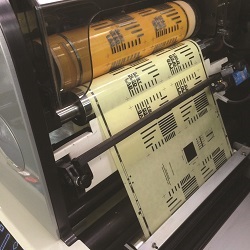Flexible OLED lighting stretches the boundaries of design
Shoppers at Marks & Spencer might notice it as early as next year: lighting is entering a new era where design constraints are gone, sustainability is a given and costs are down considerably. This is the result of a highly-innovative concept brought about by an EU-funded project where OLED, a technology that can increasingly be found in TVs, cell phones or even watches, no longer needs to rely on glass substrates and glass encapsulation. ‘We can turn the OLED upside down, maintain conductivity with alternative anodes and cathodes, process the device in a new way and protect it with a thin film. The end-product can be formed into an infinite number of design choices and it is all made possible with European expertise and know-how,’ says Poopathy Kathirgamanathan, Chair Professor in Electronics Materials Engineering at Brunel University London and coordinator of FLEXOLIGHTING. Over two years and with the building blocks in place, the consortium, which covers the full supply chain, has pushed state-of-the-art to achieve world-firsts in processing technologies. They used novel substrates such as planarised flexible steel, developed transparent top contacts with metallic films, demonstrated other alternative top contacts using conducting polymers or graphene, proved thin film encapsulation and showed how effective light extraction with their new technology can be. Better in every respect Five months away from the project’s completion, the team is now focusing on the fabrication of impactful demonstrators. ‘We set out with targets relating to efficiency, lifetime, colour, panel size, uniformity of emission, voltage drop and cost and I have always believed those targets could be achieved,’ says Prof. Kathirgamanathan. ‘In fact, those related to colour, panel size and voltage drop are already behind us.’ The consortium has also demonstrated that the cost of panels can come down dramatically by using either alternative processing methodologies such as Organic vapour phase deposition (OVPD), or solution processing techniques – to better performance than devices fabricated using traditional vacuum thermal evaporation technology. They achieved world-leading water vapour deposition rates for barrier layers and proved how devices protected with thin film moisture barrier layers are every bit as good as those encapsulated with glass. Finally, they could demonstrate: a working OLED on a steel substrate that utilises a transparent metal top contact; PEDOT deposited by polymer vapour phase deposition that has world-leading conductivity and may be a future alternative to ITO; as well as exciting levels of light extraction. Besides its lower energy consumption compared to alternative lighting solutions, FLEXOLIGHTING technology also excels in terms of material consumption. OVPD/solution processed devices mean that less raw material is wasted during device fabrication compared to VTE processing of OLEDs, and the glass and steel substrates can be recovered and recycled at end of life. ‘It is also interesting to note the growing body of evidence around the harmful effects of UV emitted by other CFLs and LEDs. OLED lighting has good colour rendering with no UV output,’ Prof. Kathirgamanathan points out. Besides project partner Marks and Spencer, which will most likely use the new technology for in-store lighting and domestic lamps, Prof. Kathirgamanathan mentions OLED-lit roofs or OLEDs integrated into the very fabric of cars and trucks as potential applications. ‘It’s very exciting to know that, within the next few years, I’ll be able to walk into shopping centres, board rooms, banks and hospitals, etc. that will be lit entirely by OLED; and that OLED displays will be commonplace in the automotive and medical sectors,’ he enthuses, before concluding: ‘I’m confident that project partners AIXTRON and Beneq will sell equipment as a direct result of the results we’ve been able to demonstrate during the FLEXOLIGHTING project. We will all see OLED lighting in stores very soon.’
Keywords
FLEXOLIGHTING, OLED, lighting, Marks & Spencer, graphene, light extraction, OVPD, vapour deposition







